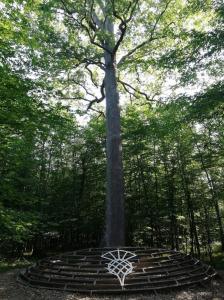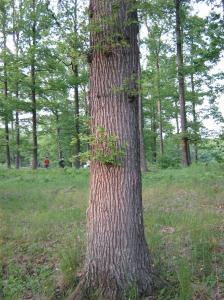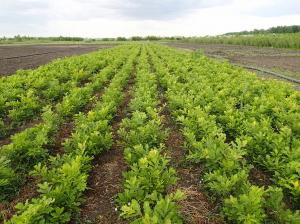Managing Sessile Oak, the 'Oak of The Mountains': An Important Timber Tree in Europe
Known as the “Oak of the Mountains,” sessile oak (Quercus petraea) is one of the most ecologically and economically treasured tree species in Europe.
HARBIN, PEOPLE'S REPUBLIC OF CHINA, CHINA, July 2, 2025 /EINPresswire.com/ -- Read the full article here: https://link.springer.com/article/10.1007/s11676-025-01868-1The species’ high heat tolerance is increasingly crucial in a warming climate. Owing to its drought tolerance and resistance to storms, sessile oak is used extensively in forestry. Covering millions of hectares, each year it produces millions of cubic meters of timber for furniture-making, construction, and fuel. Beyond its economic value, the oak trees serve as habitats for over 1000 species of birds, mammals, insects, mosses, and fungi; they also enhance air quality.
Sessile oak grows with a straight trunk and a high crown. The species is long-lived, with trees over 300 years old and the oldest one being over 1000 years old. Growth is slow until the age of 20 years on fertile sites, maintaining a fast growth until the age of 100 years and reaching heights of up to 40 meters. High quality wood production requires a rotation of at least 120 years.
Drawing from the silviculture experience across Europe, Prof. Nicolescu and colleagues elaborate on the key principles in looking after sessile oak stands in their review, covering a range of topics from how to establish and maintain a stand, and the principle of “close-to-nature” growing systems, whose aim is to make forests resilient and diverse. This work has been peer reviewed and was published in the highly ranked international forestry journal, Journal of Forestry Research (ranked 9 out of 89 in forestry with a Journal Impact Factor of 3.4 in 2024); it has a Journal Scopus CiteScore of 8.9 (2024) and falls within the 92% percentile. The journal publishes high quality review articles and original research, and is read widely by a range of scientists and forest managers.
Sessile oak (Quercus petraea) typically begins seed production from 40 to 80 years of age and are primarily produced in large quantities during mast years. While trees could be coppiced endlessly, their regenerative vigor and potential for yielding timber could gradually wane as they age and with successive coppicing. “Sessile oak is a long-lived, light-demanding, and wind tolerant species, whose timber is one of the most valuable in Europe. The species plays a crucial role in furniture-making, construction, fuelwood, and various high quality wood products.” – says Prof. Valeriu-Norocel Nicolescu.
Management focuses on maximizing timber production, especially high quality wood from large-diameter trees. Oaks are planted on rich, productive soils, and epicormic branch growth should be managed with shade from understory plants and manual pruning.
Epicormic branch growth is undesirable as they decrease wood quality. High quality wood, particularly those from large-diameter trees, is required for making solid furniture and veneer. Manual removal and using the shade from understory species can help control the epicormic growth.
Sessile oak is sensitive to early autumn or late spring frosts, various fungal pathogen species, and insect pests such as defoliators and wood borers. Adding to these challenges, oak decline is a localized but widespread phenomenon that results in higher mortality and lower vitality; it is attributed to the interplay of factors including drought, waterlogging, and pollution along with biotic influences such as genetics and pests. Thinning can help lower mortality from these factors by reducing the competition between trees.
For “close-to-nature” silviculture, embracing natural regeneration by seed following masting is more compelling than coppicing owing to its advantages for preserving genetic diversity. To provide light for seedlings, cutting is performed roughly a year after masting. Secondary cuttings are performed at certain intervals. In young stands, release cutting removes competing vegetation, while cleaning-respacing removes underperforming trees, thereby fine-tuning the spacing of the remaining forest. Prof. Nicolescu states that, "Due to its high resistance to storms, drought tolerance, and heat stress resistance, sessile oak is expected to become the most important broadleaved species in Europe’s future climate-resilient forests."
Oak populations have high gene flow levels, and they display remarkable phenotypic plasticity and genetic differentiation shaped by local site conditions across latitudes and elevations. As climate change accelerates, selecting seeds from the most resilient populations becomes crucial to secure the future of sustainable timber production.
In conclusion, sessile oak is vital in forestry across Europe. Despite the long rotations and management costs, its resilience sets it apart as an important species in adapting European forests to climate change. Through innovative strategies, diverse stands and close-to-nature silviculture can help ensure the long-term sustainability of the forests.
Andrew Smith
Charlesworth
+44 7753 374162
marketing@charlesworth-group.com
Visit us on social media:
LinkedIn
YouTube
Other
Legal Disclaimer:
EIN Presswire provides this news content "as is" without warranty of any kind. We do not accept any responsibility or liability for the accuracy, content, images, videos, licenses, completeness, legality, or reliability of the information contained in this article. If you have any complaints or copyright issues related to this article, kindly contact the author above.



